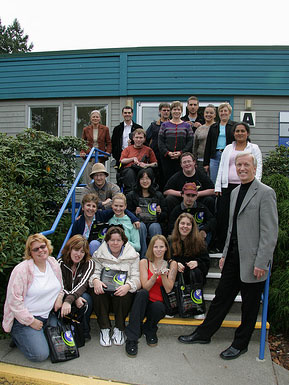Portable A: Camosun’s energy conservation winner!
Archived Content
This archived web page remains online for reference, research or record-keeping purposes. This page will not be altered or updated and may contain out of date information. If you’re looking for specific information and haven’t found it, please contact communications@camosun.ca.
 |
Ian Tol on the left (Associate Director, Physical Resources) and Peter Lockie on the right (VP Administration & Chief Financial Officer present award to Employment Training and Training and Prep Access instructors, Nancy Bourey and David Greig. |
Faculty, staff and students in the Employment Training and Preparation Programs have been reducing their energy footprint in Portable A on Interurban campus. Their success was recognized on October 29 with Camosun’s first Outstanding Contribution to Energy Conservation Award.
“Recognizing dedication towards energy conservation on our campuses is an important part of Camosun’s commitment to climate change,” says Angie Bowles, Energy Awareness Coordinator for the Camosun Energy Project.
The Energy Conservation Award acknowledges simple efforts that reduce CO2 emissions on campus. “We did not engage in any grandiose project, but rather we conserve and recycle where we can,” says David Greig, an instructor in the program.
Â
Making the shift to green
 |
Employment Training and Preparation Program students, faculty and staff outside Portable A |
Electrical use is minimized by turning off lights, monitors, printers and computers when not in use. Heat loss is curtailed by closing windows when the heat is on, turning down the thermostat and turning the heat off when the building is not in use. An extensive recycling program not only includes bins for paper, plastic and cans, but also compost bucket to divert food scraps from the Food Service Training program to worm bins. Staff and faculty use departmental bus tickets when possible and half the staff ride their bike to work regularly.
In the gardens and greenhouse, organic practices are used and water wastage is minimized with a timed watering system and the use of water-absorbing sea soil.
“We’re proud of the energy saving practices that the staff, faculty and students in Portable A have put into practice,” says Peter Lockie, Vice President Administration and Chief Financial Officer. “It’s a great example for the rest of the college to follow.”
Camosun has lots of room for green initiatives with 38 buildings that include 800,000 square feet of work and study space spread over 120 acres. Current initiatives to reduce the college’s environmental footprint can be found at camosun.ca/green.
Last updated: October 31, 2008 4:12 pm


